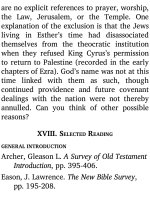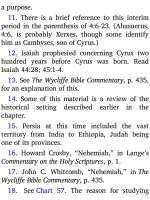Jensens survey of the old testament adam 524
Bạn đang xem bản rút gọn của tài liệu. Xem và tải ngay bản đầy đủ của tài liệu tại đây (129.51 KB, 4 trang )
A. AUTHOR
Paul identi ed himself by name in 1:1 and
3:17. The vocabulary, style, doctrine, and
atmosphere all indicate that this epistle is as
Pauline as the first letter.
B. ORIGINATION AND DATE
Both of the Thessalonian epistles were
written from Corinth, during Paul’s
eighteen-month stay there, on his second
missionary journey. The second letter
followed the rst by no more than a few
months, or around A.D. 52. This was before
the are-up at Corinth, recorded in Acts
18:5-17.
C. IMMEDIATE OCCASION AND PURPOSES
Whoever delivered Paul’s
rst letter
probably remained at Thessalonica long
enough to view the conditions at the church
and to bring back a report to Paul. The good
parts of the report are the subjects of Paul’s
commendations in 2 Thessalonians. A
negative report was that the Christians were
believing the false word that the “day of the
Lord” had already come, and therefore the
end of all things was upon them. This even
caused some of the believers to give up their
daily occupations and professions, in
anticipation of the shout and trump of
heaven heralding the Lord’s return. Those
were some of the things that Paul wanted to
write about in a second, brief letter. So the
purposes
of
the
letter
were
(1)
commendation and (2) doctrinal and
practical correction.
D. THE TWO EPISTLES COMPARED
Some of the main di erences of the two
epistles are shown on Chart 93. These will
become apparent as you survey 2
Thessalonians.
CHART 93: FIRST AND SECOND
THESSALONIANS COMPARED
It will be seen from these comparisons
that the two epistles di er mainly over
which phase of the Lord’s return is in view.
In 1 Thessalonians, the rst phase (rapture)
is the main subject. In 2 Thessalonians,
attention is focused on the second phase
(revelation). In order to see if the above
distinctions are justi ed it would be
necessary for you to analyze carefully the
text of the Thessalonian letters. Such
analysis is beyond the scope of these survey
studies. As a background for examining
whether the two epistles are emphasizing









